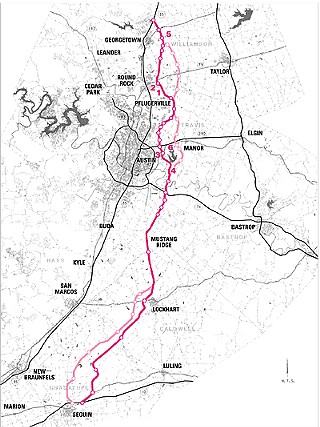SH 130 Hot Spots
By Mike Clark-Madison, Fri., Jan. 21, 2000
The Texas Turnpike Authority has looked at western and eastern SH 130 alignments in three different segments, thus producing eight (2 x 2 x 2) alignment options.
The TTA prefers No. 3 -- west/west/east, the red line -- but Austin, Travis County, and Round Rock have all officially backed an eastern alignment (presumably No. 2, east/east/east). Other local jurisdictions have backed TTA's preference -- in some cases (such as Williamson County) doing so before TTA even had a preference. Caldwell County and the city of Mustang Ridge have so far been silent on the alignment issue.
The exits marked on the map are TTA's proposed locations for toll ramp plazas -- that is, places where you'd pay to get off the road -- as well as interchanges with other state roads. Since TTA is still doing its feasibility study for the toll-road option, this is by no means a final list. Little things mean a lot, especially when you're planning a project like SH 130 that's governed by a raft of federal regulations. Here are some of the hot spots that TTA will have to contend with:
MoKan Prairie (1)
The preferred route would take about two acres of this privately owned parcel south of Gattis School Road in Round Rock, part of a 12- to 18-acre remnant of the native prairie grassland (predominantly little bluestem and Indiangrass) that once covered the middle third of the U.S. but is now recognized to be rare and threatened. (Other surveys say the MoKan Prairie parcel is bigger.) There's no federal law -- yet -- protecting prairie remnants, but the EIS anticipates some sort of mitigation being needed here.
Kenney Fort (2)
Just north of the MoKan prairie is this site, listed on the National Register of Historic Places. Archeologists have found prehistoric artifacts here and suspect that the site was inhabited; it was then the point at which the old Double File Indian Trail crossed Brushy Creek; and later it was one of the earliest Anglo-American settlements in Central Texas. There are a number of potentially significant historic and archeological sites along the SH 130 corridor, but this is the most clearly significant site that's directly in the proposed right of way. Federal law requires a lengthy analysis of such sites, which has only just begun here.
Colony Park; Turkey Farm (3, 4)
These are existing Austin and Travis County parks, respectively, though neither has been developed or improved and, according to the EIS, neither is used by citizens. (The Turkey Farm is actually fenced and locked.) Travis County has asked that TTA go alongside the Turkey Farm, while Austin has asked that TTA dedicate replacement parkland and put in sound barriers and a pedestrian underpass where SH 130 traverses Colony Park. The SH 130 route also goes alongside Travis County's proposed Northeast Metropolitan Park and through the Walnut Creek area just west of Colony Park, eyed by Austin for one of its "destination parks."
Wetlands
By federal law and executive order, highway projects need to avoid wetlands whenever possible, but the EIS says "it would be impossible to construct a roadway running north to south through the study corridor without crossing wetlands associated with the southeast-flowing drainage systems" (i.e., the Brazos, Colorado, and Guadalupe basins). To figure out how to go over or around or otherwise mitigate SH 130's impact on each of the nearly 70 river and creek crossings, plus the more than 80 stand-alone ("polygon") wetlands along the preferred route, TTA consultants will have to visit each one, which will take a while.
Birds and Bass
Most of Central Texas' storied inventory of rare species are endemic to the Edwards Plateau -- which is why they're rare -- and most of SH 130 runs well to the east of the Balcones Escarpment, so TTA does not expect SH 130 to hurt any vireos, warblers, cave bugs, or salamanders. Migratory birds are another matter -- everything from the least tern to the whooping crane has at one time or another been spotted in the four counties crossed by SH 130, and the mountain plover, which is being considered for "threatened" status and which winters in meadows and fields, has been spotted in all four. Other species that may be troubled by SH 130 include the Guadalupe bass, Texas garter snake, and horned lizard.
Two Rivers (5,6)
The expected SH 130 bridge over the San Gabriel River (5) -- which cuts through the SH 130 corridor's otherwise tight soils -- is the most likely point at which highway runoff could contaminate the Edwards Aquifer, whose recharge zone only covers the northernmost part of the alignment. So the crossing will need extra mitigation to divert and contain runoff and construction debris. The Colorado River crossing (6) poses no special environmental issue, but because the river is considered navigable from the Gulf all the way to Longhorn Dam, TTA may need a permit from the Coast Guard to bridge it.
Got something to say on the subject? Send a letter to the editor.









